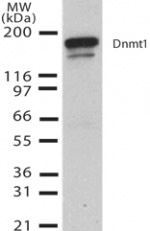DNMT1 antibody (mAb) (Clone 60B1220.1)
Host / Isotype
Mouse / IgG
Reactivity
Human, Mouse
Applications
ChIP, IHC, IP, WB
CloneNo.
60B1220.1
Cat No : 39204 39204
Synonyms
Validation Data Gallery
Product Information
| Tested Applications |
ChIP, IHC, IP, WB
Applications Validated by Active Motif: WB: 2 - 4 ug/ml dilution For DNMT1, we also offer AbFlex DNMT1 Recombinant Antibody (rAb). For details, see Catalog No. 91175. |
| Tested Reactivity | Human, Mouse |
| Host / Isotype | Mouse / IgG |
| Class | Monoclonal |
| Type | Antibody |
| Immunogen | This DNMT1 antibody was raised against a peptide corresponding to amino acid residues 637-651 of human DNMT1. |
| Full Name | DNMT1 antibody (mAb) (Clone 60B1220.1) |
| Synonyms | DNMT1, DNMT-1, DNMT 1, mAb, monoclonal, DNA Methyltransferase 1, antibody, antibodies, chip, chromatin immunoprecipitation |
| Molecular weight | 190 kDa |
| GenBank accession number | NP_001370 |
| RRID | AB_2614950 |
| Purification Method | Affinity Purified |
| Buffer | PBS containing 0.05% BSA and 0.05% sodium azide. Sodium azide is highly toxic. |
| Storage | Some products may be shipped at room temperature. This will not affect their stability or performance. Avoid repeated freeze/thaw cycles by aliquoting items into single-use fractions for storage at -20°C for up to 2 years. Keep all reagents on ice when not in storage. |
Background Information
DNMT1 (DNA (cytosine-5)-methyltransferase) proteins are involved in DNA methylation in which a methyl group is added to a cytosine residue on DNA, commonly at the C5 position of a CpG dinucleotide. Three families of DNMTs have been identified: DNMT1, DNMT2, and DNMT3 (comprised of DNMT3A and DNMT3B). DNMT1 is the most abundant DNMT in somatic cells and shows a preference for methylating hemi-methylated DNA. It is considered to be a maintenance DNA methyltransferase that is important in the maintenance of specific patterns of methylation throughout cellular divisions. Methylation of mammalian DNA has long been recognized to play a major role in a number of cellular functions such as embryonic development, genetic imprinting, X chromosome inactivation and the control of gene expression. DNA methylation is generally associated with transcriptional repression.

